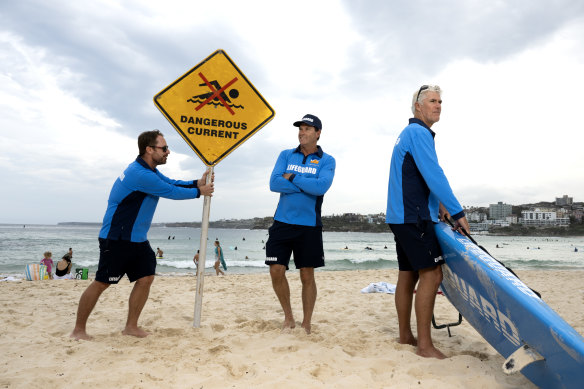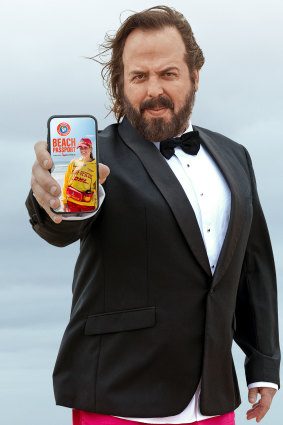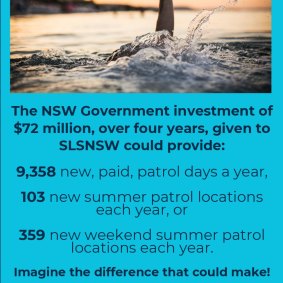With a hot summer on the way, surf lifesavers get little help from Mad Max
By Julie Power
Nobody drowned at patrolled beaches on Australia’s coast last year, but a record number of people – 150 nationally, including 61 in NSW – died outside patrolled areas and times.
How to prevent more drownings on a coast the size of Australia, with 890 beaches across 1600 kilometres of coast in NSW alone, is the question ahead of a forecasted hot summer.

Lifeguards Troy Storm Quinlan, Bruce “Hoppo” Hopkins and Tommy Woodriff at Bondi Beach. A new report calls for better coverage at dangerous, unpatrolled beaches. Credit: Louise Kennerley
Two different approaches were launched on Tuesday. A group representing councils and land managers that employ professional lifeguards called for more funding to extend coverage to unpatrolled risky and popular spots such as Dreamtime Beach in northern NSW.
Another approach came from Surf Life Saving Australia, which launched a new campaign targeting men, who represent 86 per cent of coastal drownings on unpatrolled beaches.
The bearded face of the campaign is the Organic Mechanic in Furiosa: A Mad Max Saga – actor and former Freshwater nipper Angus Sampson. He warns the ocean is compelling and unpredictable, a bit like him.

Hollywood actor Angus Sampson is fronting a new national safety campaign.Credit: Surf Life Saving Australia
The campaign’s message is: Stop. Look. Stay Alive, and will be adopted by water safety organisations across Australia. It includes a new virtual training platform called the Beach Passport with water safety knowledge at beachpassport.org.au.
At the launch, Sampson described himself as a “former Freshie nipper and clubbie” who had commuted from Sydney’s inner west to the northern beaches for six years until he was 15. “I have such fond memories of spending my time on the beach without it seeming to be a chore, and I was so privileged to be around the surf.”
“Obviously Surf Life Saving can’t be everywhere all the time,” said Sampson, suggesting that the public educate themselves before hitting the beach.
But the Coastal Safety Group, representing lifeguards at 25 coastal councils, has called for more funding to extend professional lifeguard services to some unpatrolled beaches that are both dangerous and popular. If that funding isn’t available, it wants a share of the record $72 million that Surf Life Saving NSW will receive from the NSW government over four years.

Coastal Safety Group argues that more funding could extend lifeguard coverage at many beaches. Credit: Coastal Safety Group
Coastal Safety Group secretary Tony Blunden said: “We could do a much better job at data-based decision-making around where we actually apply our efforts to reduce drownings. What we hear quite often is, ‘We’d love to patrol more beaches, but we can’t afford it.’ But you could use [some of the funds provided to Surf] to just patrol more beaches.”
Coastal councils spent $32 million for nearly 17,000 patrol days, which resulted in about 70 per cent of NSW rescues. The CSG’s analysis found an additional $702,081, for example, could provide a full year of service at a new location.
NSW Minister for Emergency Services Jihad Dib says the number of coastal drownings in NSW is “deeply concerning”. It prompted a Coastal Water Safety Roundtable to look at strategies to make beaches safer.
“That includes opportunities to encourage greater collaboration across a range of initiatives to prevent drownings, including efforts by paid and volunteer lifeguards, which I see as complementary.”
“While paid lifeguards are often allocated to the busiest beaches (in many cases complementing volunteer patrols), our record investment [in Surf Life Saving] is also targeting unpatrolled higher-risk locations through the use of emergency response beacons, jet skis and drone capabilities.”
Surf Life Saving NSW chief executive officer Steve Pearce said a large proportion of coastal drownings represented in drowning statistics included those in unpatrolled locations near rock platforms and headlands and remote beaches rarely visited by the public.
Pearce said of the 61 coastal drownings in 2023-24, 52 per cent occurred at beaches. The balance involved rock fishing, boating, diving, falls and incidents in Sydney Harbour waterways where it would not be feasible to provide active lifeguarding and lifesaving.
Pearce said he didn’t want to be adversarial. It was for the benefit of the community that these paid lifeguards and volunteers worked together.
While lifeguards were mostly employed over summer, Surf Life Saving’s service was “24/7 every day of the year. We have call-out teams and surveillance throughout the years.”
Start the day with a summary of the day’s most important and interesting stories, analysis and insights. Sign up for our Morning Edition newsletter.